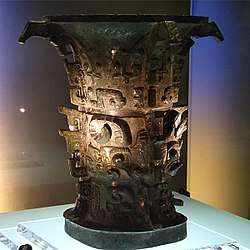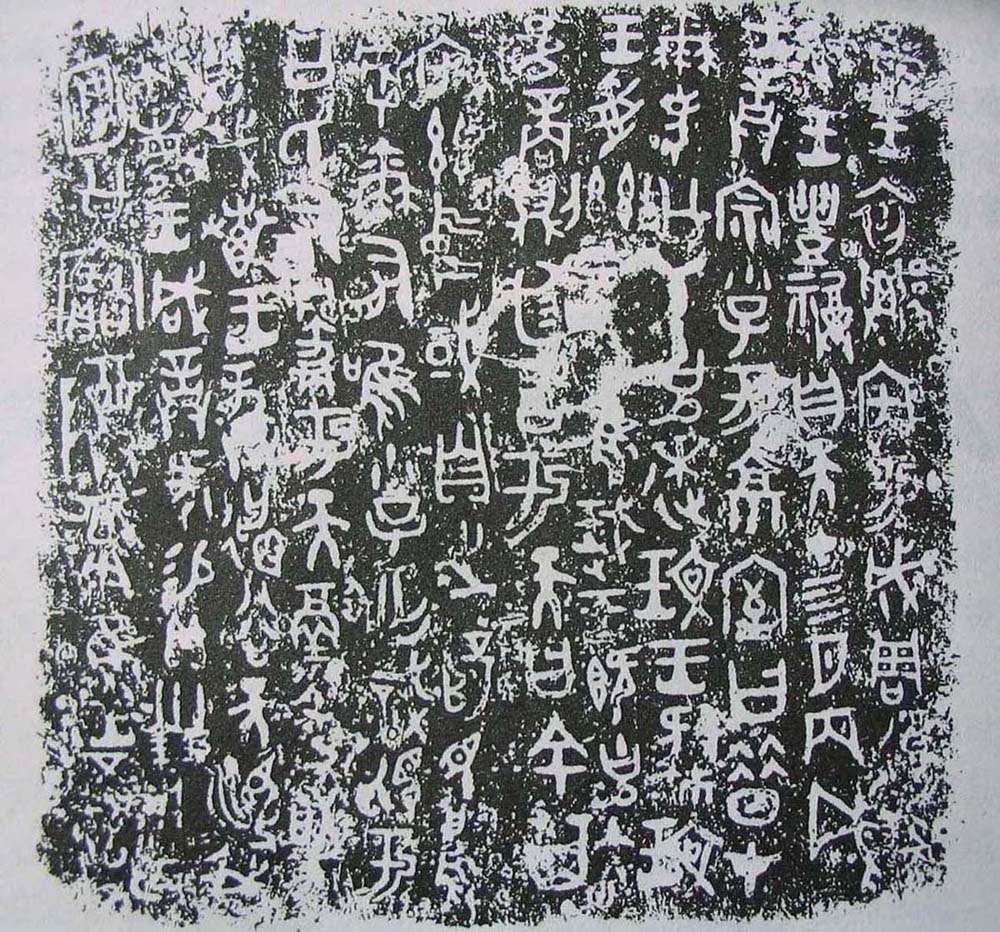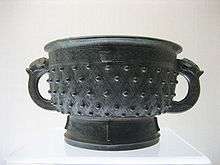He zun
The He zun (Chinese: 何尊) is an ancient Chinese ritual bronze vessel of the zun shape.[1] It dates from the era of early Western Zhou (1046–771 BC),[2] and is famous as the oldest artifact with the written characters meaning "Middle Kingdom"—that is, "China" (中國)—in a bronze inscription on the container.[3][4] Today it is in the Baoji Bronzeware Museum in Shaanxi.[1]


Dimension and significance
The vessel, dating to the 5th year of the reign of King Cheng of Zhou, is 38.8cm tall, 28.8cm in diameter and weighs 14.6kg.[1] Inside the container, at the base, it contains 12 rows of 122 inscribed Chinese characters.[3] Of the 122 characters, 119 are identified while 3 are unknown.[5] Among the characters is the phrase (宅茲中國) inscribed in Zhou era form. This is the earliest known artifact to contain the word "Middle Kingdom/China (中國)".[3][5] It is also the earliest known vessel bearing the character de (德).[6] The He zun later became one of only 64 designated pieces of historical artifacts that can never leave Chinese soil.[7]
History
The construction of the city of Luoyi (洛邑) is documented in two chapters of the Classic of History. The inscription of this vessel supports the textual claim.[8] Historians believe King Wu of Zhou was at Haojing (鎬京) at the time after the construction of Luoyi.[9] The record shows King Cheng of Zhou established his residence in Chengzhou (成周) in his 5th year. Most scholars consider this was 5th year after Duke of Zhou handed over the government.[8]
Discovery
The lost artifact was discovered by a Chen family. Behind their house in Baoji was a 3 metre tall cliff.[1] One cubic metre of the piece was sticking out from the soil. In 1963 the second son of the family dug out the piece thinking that someone might be hurt by the protruding part.[1] The piece revealed a taotie design. The family did not grasp the value of the vessel, using it as a food storage container at home. On August 8, 1965 the family struggled with financial difficulties and sold the piece along with other unneeded items to a waste center in Baoji for 30 yuan.[1]
In September 1965 a worker in the waste center informed an expert about the bronze piece. The expert recognised it as a Zhou dynasty artifact and brought it back to a museum.[1] In 1975, near the end of the Cultural revolution, the State Administration of Cultural Heritage sent the piece to the Shaanxi relic bureau. Ma Chengyuan, a bronze expert at the Shanghai Museum, recognised its significance.[5]
In 1976 the PRC cultural bureau organised an art exhibition to the United States. The US requested this piece join the exhibit and offered a US$30 million protection coverage.[5]
See also
References
- Xinhuanet.com. "Xinhuanet.com." 何尊. Retrieved on 2010-05-01.
- Wolfgang Behr (2004). "'To Translate' is 'To Exchange' — Linguistic Diversity and the Terms for Translation in Ancient China". In Michael Lackner and Natascha Vittinghoff (ed.). Mapping Meanings: The Field of New Learning in Late Qing China. Brill. p. 176. ISBN 9789004139190.
- big5.7qiji.com. "China's 7 wonders (中國七大奇蹟)." 何尊. Retrieved on 2010-05-01.
- For a transcription of the vessel's text, see Academy of Chinese Social Science Archaeology Research Institute, ed. (2001). 殷周金文集成釋文 [Transcribed Texts of Collected Shang and Zhou Bronze Inscriptions]. 4. Hong Kong: Hong Kong Chinese Culture University Press. p. 275 (no. 6014). ISBN 962-996-039-7. This differs from the reading offered on the vessel's Chinese wikipedia article. See also Shirakawa Shizuka (白川靜) (1962). "48.1". 金文通釋 [Complete Explanations of Bronze Inscriptions] (in Japanese). 6. Kobe: Hakutsuru bijutsukan. pp. 167–80.
- Qkzz.net. "Qkzz.net." “中国”一词的最早记录者——何尊. Retrieved on 2010-05-01.
- 郑勇 (北京师范大), "由《遂公盨》看西周金文中“德”观念的演变". 学语文学 2012.2:3.
- Wenbao.net. "Chinese cultural heritage protection official web list." 何尊 . Retrieved on 2010-05-01.
- Li Feng. [2006] (2006) Landscape and power in early China: the crisis and fall of the Western Zhou, 1045–771 BC. Cambridge university press. 0521852722, 9780521852722. pg 63.
- News.chinavoc.cn. "News.chinavoc.cn." 西周何尊赏析. Retrieved on 2010-05-01.
